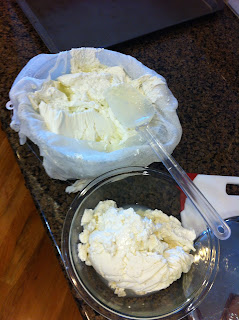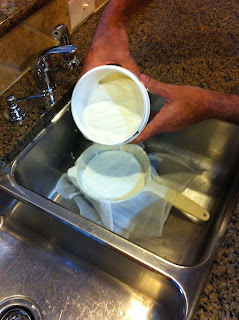A day by the pool, a cold crisp Prosecco.....and fresh cheese rolled in mild, sweet and warm, young ginger bits. Oh my this is special.
Now it is really easy. You will need:
1 Gallon of Milk (I used whole 365 organic milk from Whole Foods)
20 drops of liquid rennet
20 drops of calcium chloride
1/8 teaspoon Mesophilic starter and if you don't have that 1/4 cup butter milk
Cheese Cloth
1 big pot with a lid
Somewhere to hang it
1 2oz bag of Verdant Kitchen - Beachcomber Ginger Bits
OK so you need to start this Friday evening to enjoy it around the pool on Sunday afternoon.
Add one gallon of whole milk to a pot and stir in 20 drops calcium chloride mixed in 1/4 water
Stir in mesophilic starter
Let it sit on the counter for one hour and then add 20 drops of liquid rennet mixed in 1/4 cup water and mix in well.
Let sit for 12 hours, overnight, at room temp (75 F)
After 12 hours it will have formed a solid curd. Cut the curd in both directions with a knife that reaches the bottom of the pot and then again at 45 degrees. Once you are done it should look like this
 |
| These are about 1/2 inch pieces |
Ladle it into a collander lined with cheese cloth - I used two pieces of cheese cloth to make roughly 2* 3/4 lb of fresh cheese.
 |
| I split it into two |
You want to hang it for 12 hours to drain and culture at room temp. Then unwrap it, invert the ball of fresh cheese and rehang it for another 12 hours.
When you are done you have a soft, creamy fresh cheese.
 |
| All drained |
 |
| Unwrapped |
I then take some plastic food wrap, divide it into four and put them in the refrigerator to firm up
OK now for some fun. Take one out of the refrigerator and roll it in your favorite coating. Given that it is a summer day by the pool I went for dried fruits and ginger.
I did two variations both with Beachcomber Ginger Bits, it gives a mild, sweet and warm background. Just a magic complement to the sweet fresh cheese. The first had some dried papaya and pineapple diced.
 |
| Dice and add the ginger |
 |
| Coat all sides |
The second one had just ginger
 |
| OK Yes I ate the end from this... |
Put them back in the refrigerator until you are ready to serve.
They both went well with some crackers and fruit. The ginger only one has an amazing and subtly taste. We also had it with some wildflower honey from our friends at Atlanta Honey - this was really special. The mild floral honey complemented the ginger.
 |
| Great by itself |
 |
| and even better with Honey |
Oh and as you can see this one didn't make it to the afternoon and wine, a cappuccino made on the excellent Savannah Blend from our friends at Savannah Coffee Roasters
Live Well - Eat Well































